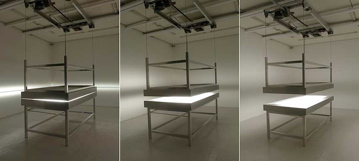
Alfredo Jaar, "Lament of the Images (Version 2)," 2002
At one point in my panel conversation with Olivia Gude, Mark Bradford, and William Crow at the National Art Education Association’s annual conference in Minneapolis, the discussion got around to our hopes for the future of art education. Olivia Gude, in a way only she can truly communicate, actually hoped that students would “make less art” in the future. This week’s question from the NAEA conference (our last in a series of columns dedicated to questions from that panel, titled Art Practice, Teaching Practice) comes from Bobbi Meier, who teaches on the secondary level in River Forest, IL. Bobbi asked, “How do we make ‘less art’ and keep our program intact? Administrators are looking for product!”
As we move forward as artists and art educators, it’s important to make people understand (collectors, art lovers, students, parents, administrators, and policy makers) that quantity in an art program has little to do with quality. As a matter of fact, and I believe this is what Olivia was getting at, it’s important to allow students time for immersion into the themes, questions and big ideas that can drive significant units of study on all levels. While it’s not as glamorous to ditch the series of projects about “mastering” the elements of design in favor of a longer-term painting project that focuses on a big, essential question, there are ways for students to demonstrate understanding and even “mastery” of the elements through their work in a more significant unit that’s driven by a meaningful question(s) or idea.
Working with administrators to help them understand how and what our students are learning can go along way towards convincing them that the quantity is not what’s important. What’s important is listening to students describe, demonstrate, and write about their learning experiences in the art classroom, even when the product isn’t pretty or plentiful. Here are a few specific suggestions:
- Invite your principal or supervisor in to see a variety of lessons over time, not just when an observation or evaluation rolls around. It takes time to digest what we do with people who aren’t as experienced with the visual arts.
- Start a class webpage that communicates with the school community (including the school board) the themes and questions that drive units of study in your classroom. Share your curriculum maps (or, if necessary, START curriculum mapping and share your plans).
- Create or re-imagine a gallery or exhibit space in your school or district. Create a regular schedule of shows that allows teachers and students a chance to share a variety of work over time. Encourage students to share how that variety of work was inspired and how it relates with classmates, parents, community members, administrators and colleagues.
The first step, perhaps, to making less art is helping others understand what we do, and that what we do involves planning and thinking and shaping possibilities in order to come up with quality work in the classroom. While projects that focus on “mastering”elements or specific techniques can be cute and catchy, it doesn’t necessarily make for a quality art program. Everyone is always impressed with true learning. The challenge is to make that learning as exciting to share as the flashy projects that may not have as much thinking behind them.




Pingback: Straight from the Source | Art21 Blog
Pingback: Artability « Center for New Media and the Arts